|
John Edward Hummer was born on February 8, 1883.
He came over from Finland on a ship by himself when he was 15 years
old. The year was 1899.
In the Harbor, he went by his middle name, Edward.
I wonder why ?
Edward's life before coming to America and when he first arrived is a mystery.
He would never talk about his past to the children.
Lil says, "He came from Vaasa Lääni."
Edward was born in the Village of Laihia, in Vaasa Lääni, the Province
of Vaasa on the Western Coast of Finland. Laihia is about 14 miles (24 km) southeast of Vaasa. Edward's naturalization
certificate said he was from Russia because Finland was ruled by Russia from 1809 to 1917. From 1200 to 1809, Finland was ruled by Sweden. The Swedish name for Laihia is
Laihela, and the Swedish name is written on other documents we found.
Note : The story of Edward Hummer is based
on my research of mining in Upper Michigan. We have not YET been able to find record of Edward Hummer in any of the
Michigan towns that Aunt Lil mentioned. This is the greatest mystery of our story. My brother remembers
finding a piece of paper with names that Dad kept in the family bible. Names he remembers might be Matt Hummer
and Mary Naskali.
Could Edward's father have been named Matt Hummer?
Yes, it is true.
On October 13, 2005, I received a letter from Kari T. in
Finland with the following, wonderful news.
(Kari is the great grandson of Isaac Emil Ollila, 1877-1945.
"Iikka" was Kalle's brother, Hilma's uncle, and the only Ollila who did not leave Finland. Our family has
enjoyed a correspondence with Kari since he first found Aunt Lil in 1997.)
Because of Kari, we have knowledge of our Ollila family
and now , more of our story we have been yearning to find, the mystery of the Hummers. I know he worked long, late hours to find this information, and
we are ever so grateful to him.
October 13, 2005
Dear Jody,
You ARE (partly) from Laihia.
Most Laihia registers,
unfortunately, are not covered by HisKi system. I was facing the same problem when making a research at National Archives.
With the help of a friend of mine Ms. H., I received today a pleasant message with some extra information. Now, the basic
information is in our hands!
Juho Edvard (in church register: Eetvartti) HUMMER was born on 8 February 1883 in Laihia,
Province of Vaasa, Finland. His parents were:
Father Matti Juhanpoika (Son of Juha/Johan) HUMMER, earlier ERVING, born on 9 August 1859 in Laihia, Tuori house
number 8 of Yrjäälä village, and mother, Maria Heikintytär (Daughter of Heikki/Henrik) HUMMER, earlier KONSTER, born on 14
May 1864 in Laihia.
The Laihia church register says, that Matti was in America, and furthermore, that they divorced on 18 November 1893.
This is very exceptional, but it may mean that Maria was so-called "American Widow". That category was not exceptional at
all. When a husband was in America and the wife stayed in Finland, and the contact was lost, no correspondence, no sign what
so ever, the parish could solve the problem with a divorce procedure.
Yrjäälä village is in the center of Laihia,
near the church and parish village. Surname Erving seems to have lived there since late 1600s. The Konster family comes from
Käyppälä village, some 5 km south from the church. Also this family has been there at least from late 1600s. So, you cannot
escape the fact that you have Laihia blood. However, as a balancing force, Isokyrö parish is around the corner. In fact, both
Isokyrö and Laihia people were often using the same railway stop at Tervajoki.
Mother of Juho Edward, Maria Heikintytär
HUMMER re-married on 23 December 1893 with Mikko Tuomaanpoika ANNALA (born on 2 November 1862). Probably at least one child.
So,
father Matti must have left Finland between 1883 and 1893 and probably never returned to Finland. In principle, the explanation
or answer should be found in America. Some twenty years later, it was son Juho Edward HUMMER who left Finland.
Yours
Kari
|
|
| Kari's Map, Click for large image. |
Lil says: "He came all by himself. He had a tag on his coat with his
name and destination. After he came out of [immigration], they put him on a train to wherever he was going. Ispeming,
Negaunee and Ironwood, to which one he went to first, I don't know. His father was in Upper Michigan. At that early age, I don't know what kind of work he could get, but he went
to work in an iron mining town."
The Iron Men
The towns of Negaunee, Ishpeming and Ironwood were built on top of iron
ore. The land was so hard, the mines were carved of solid rock.
We have no record of his name, or why he came, but in the mining towns in
Marquette County, along the western edge of the Upper Peninsula, there are stories left behind where Edward and his father
might have lived...
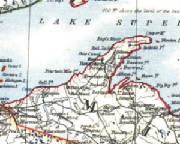
|
| Ishpeming, Negaunee, Ironwood, 1901. Click for larger image. |
"Most of the Finnish men worked in the mines.
Many times,
in the last column of early church records, there appear the words 'Died in a mining accident.' When there was an accident,
the Finns were often buried under a slide of rock deep in the mine.
Their sons, 13 and 14 years old, sometimes worked
as errand boys whose duties consisted of all kinds of small tasks such as carrying water and tools to workman. Their working
hours and the dangers they were exposed to were the same as those of the miners."
--The History of the Finns
in Michigan, Armas Holmio
"Life was raw in the iron towns. The majority of the men lived
in rooming houses which were also called 'flop houses', and the only gathering places were saloons.
The streets were
covered with earth that was red from its iron ore content. The red dust settled everywhere, so that church pews and saloons
alike were red."
This excerpt from "The Journal
of Otto Peltonen", is a fictional, but accurate account of iron mining in Hibbing, Minnesota, not far from Ironwood, Michigan
in 1905---
"Father's beard was wild and untrimmed. His
clothes and hands were stained a rusty color, and his fingernails were rimmed with red dirt. He explained that the red stains
on his clothes were iron ore dust that wouldn't wash out. He's covered with so much ore dust that his eyes are two white holes.
His shirt and pants are streaked with wax drippings from the candle that he wears on his mine helmet."
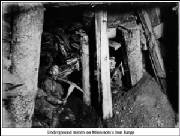
Clicking on pictures thoughout this site will often take you to larger images.
A continuous stream of ships carried the ore through the Great Lakes from Minnesota and Michigan to Ohio. From there, it
went by railroad to all points for the American steel industry.
Our own G. David Lesperance was a Marine Engineer on the
ore boats, the great "lakers". He used to leave home in the middle of March and would never come back until right before Christmas.
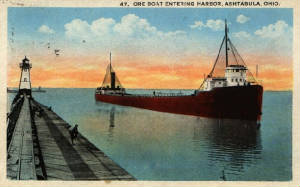
|
| The Thomas Cole Ore Boat entering Harbor |
Iron ore is red gold. It's value is in our factories and skyscrapers; our
cars, ships and planes, farms, railroads, bridges and roads. Our tools and all the great machines that built these things
are made of iron ore.
These men provided the ore that made the iron that made the steel that built the great cities
and industries of Cleveland, Chicago, Detroit, Pittsburgh, New York, America.
It was said that these were iron men
of iron will.
Harbor, America
When Edward first came to Ashtabula Harbor, the town was so well known that
mail from Finland was often addressed simply to Harbor, USA.
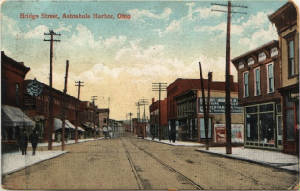
|
| Bridge Street, Ashtabula Harbor |
How long Edward stayed in the Upper Peninsula or what happened to his father,
we aren't sure, but he found work at the Ashtabula Harbor docks, unloading the iron ore from the ships that had carried it
from the mines he left in Michigan.
Clicking on photos will often take you to larger images.
| Courtesy, Library of Congress |
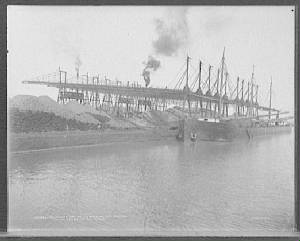
|
| Early Ore Unloading, before Huletts. 1900. About the time Edward arrived from Michigan ? |
The iron ore was shoveled by hand.
"A shoveler, in order to make $5.00 a day, must
shovel 50 tons each day. It takes 125 shovels to fill each 1 ton bucket, so he fills and empties his 21 pound shovel, 6,250
times a day.
The Ashtabula News remarked that "a person's sympathies cannot but go out to the dock hands in their
hard lot. It does seem to us that they are living a life of death by inches."
| Courtesy Library of Congress |
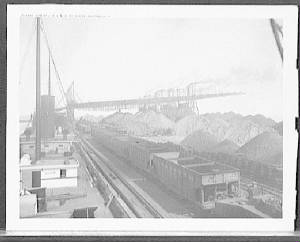
|
| Early Ashtabula Harbor. |
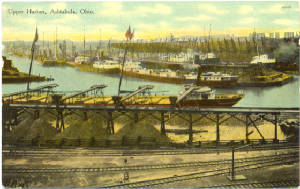
|
| Upper Harbor |
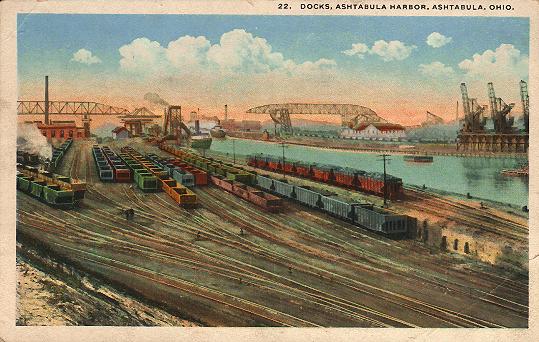
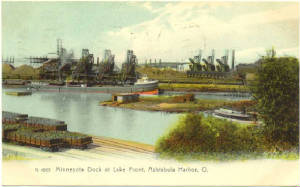
|
| Minnesota Dock, 1909. |
Clicking on photos will often take you to larger images.
46 years, Edward Hummer worked for the Ashtabula & Buffalo Dock Company,
("the A & B.") from laborer, to oiler, to engineer to operator of the Hulett Automatic Ore Unloaders, magnificent
machines that revolutionized the iron, coal and steel industry in America. He worked on the Superior
Dock, located on the west side of the center island below, where the Ashtabula River begins.
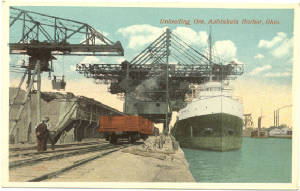
David Lee says:
This is the Pennsylvania Dock. The machines pictured are Brown Machines, used before the Huletts. Uncle Arnold Ollila
worked there as well as my Uncle Ray Raisenen, who was a cousin of Aunt Lil's, as well as her brother-in-law. Are you totally
confused now? Ray was married to my Aunt Helena ,Dad's sister.
| Courtesy Great Lakes Industrial History Center |
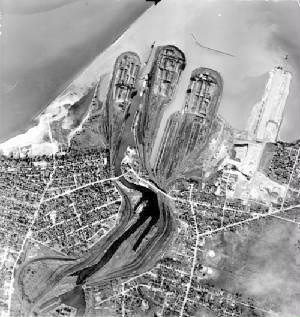
|
| Superior Dock, (A & B) is the west side of the center island, where Grandpa worked. NOTE: CHECK THIS |
The Great Huletts
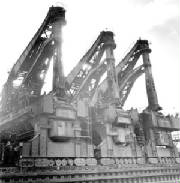
|
| Port of Cleveland, 1964 |
The Hulett was invented and patented by George Hulett in 1898.
The first working model was erected at Conneaut the next year.
Ashtabula Harbor, Cleveland, Lorain, Huron and Toledo followed by 1900-1905.
Four of these machines, working as a battery, could unload the largest ship
in less than half a day. To shovel the ore by hand, a crew of 129 men would have worked a week to do the same work.
It
was said of the great Hulett that "only God could have designed a finer piece of machinery."
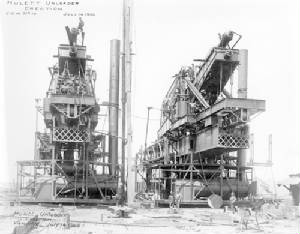
|
| Conneaut Harbor, Dock 4, July 14, 1900 |
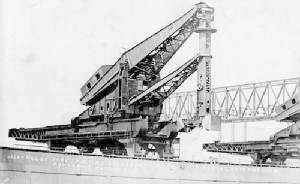
|
| 1900 Hulett at Superior A&B Dock where Edward worked. |
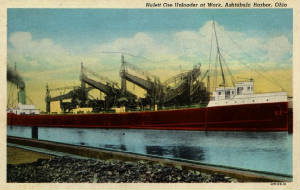
|
| Hulett Ore Unloader |
Clicking on photos will often take you to larger images.
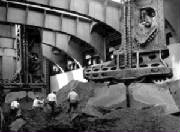
|
| Port of Cleveland, 1935 |
By 1930, the Depression brought the great iron industry to a standstill.
These must have been rough days for the Hummer family with nine of the ten kids at home.
During World War
II from 1939-1945, America needed huge amounts of iron for the war effort.
Iron made the aircraft, ships, tanks, jeeps and bombs. When the lake fleets
had moved only 4 million tons of ore in 1932, they moved over 92 million by 1942.
Edward was 59 years old at the height
of this effort. Four of the Hummer boys were off at war. He must have thought about his sons every day as he filled the acres
of ore cars. It must have kept him going.
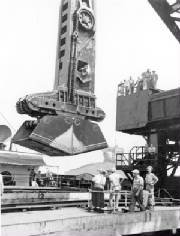
|
| Port of Huron. 1950 |
The Hulett requires 2 operators. One rides inside the vertical leg, as in
a giant's foot. He controls the bucket. The other operator rides in a cab on the Larry, a carriage that moves the Hulett along
the dock, weighs the ore from the bucket and transfers it to the rail cars. A 1946 letter from son, Roland, tells
us which position Edward worked.
Click here to read about the effort to save the Cleveland Huletts
January 8, 1946
Dearest Mother and Dad,
Received a nice letter from Butch and Lelah, had a large snapshot of the model unloading
machine that one of the Pearson boys made. Can just see Pa sticking his head out of the Larry car. God bless you and watch
over you, Ma and Pop.
Your son,
Roland
This
Pearson model is the world's only working scale model of a Hulett and is displayed at the Marine Museum in Ashtabula. Click
the link below and read David Lee's personal account of operating the great Huletts, just like his grandfather did.
Here is a rare photo we just found of the Larry Car in operation from a National Geographic, date unknown. It's possible
that Edward is operating the very car in that photo...
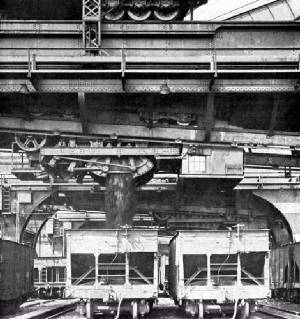
|
| Larry Car in Operation. Possibly Grandpa. National Geo, 1918 ? |
Photo of Larry Car, courtesy of National Geographic and Thomas Ehrenreich's
site, Railroad Extra. We would love to locate the original NG and think it might be October, 1918.
(September and November are about Shipping and the Coal Industry.)
Ehrenreich writes on his page in tribute to "All the Men, Women and Children of
the Coal, Steel, Iron and Railroad Industries":
LOADING ORE INTO CARS AT ASHTABULA, OHIO
The most massive ore-handling machinery in the world is in use at this great lower lake port. Here
come untold millions of tons of ore to be transhipped to Pittsburgh, Youngstown, and other blast furnace points. The big Hulett
unloader dumps its burden into a bin almost as soon as it is out of the hatchway. While it is diving down into the hold for
another load, the bin, which is mounted on wheels, moves away and dumps its contents into waiting cars, as seen in the picture.
By the time another mouthful is ready the bin is back to receive it. The cars are standing under the rear end of the unloader.
Interesting Page in Tribute to All the Men, Women and Children of the Coal, Steel, Iron and Railroad Industries. National
Geographic 1918
David Lee's Story of Days on a Hulett
We received a wonderful letter from David Lee,
Edward Hummer's grandson who came to run the very same Huletts
as his grandpa, only forty years later.
This is his story...
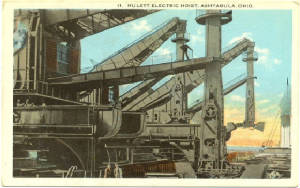
|
| Hulett Electric Hoist, Ashtabula Harbor |
Day on a Hulett
By David Lee
05/01/02
When I was little, I remember Grandpa Hummer coming home from work with his coveralls and lunch bucket. He was about six
feet tall and to me he was a giant.
He worked at the Ashtabula and Buffalo Dock as a Larry car operator. The Larry car was in fact a very large scale hung
from the underside of the hulett. It was suspended from tracks that ran the length of the hulett. His job was to wait for
the hulet operator to dump the ore from his bucket into a hopper above the Larry car. He would then" grind out "the
ore. A very loud grinding sound was made as this was done, hence the term.
He would then weigh the ore and when he had the correct amount in the larrycar hopper he would either travel the length
of the hulett or dump it in the "pit", which was a U-shaped set of concrete walls. It ran the length of the dock
and was used as a holding area for the storage of ore on the dock. It would then be scooped out of the "pit" by
a huge gantry crane that was capable of traveling the entire length of the dock on four sets of "trucks", a series
of wheels sitting on tracks.
The other option was to take it to one of four tracks, which was assigned to that hulett and dump it into a waiting railroad
car. The cars were brought to the huletts by means of a cable system that ran the entire dock. The r.r. cars had the amount
of ore it would hold stenciled on the side, so the operator would have to weigh the correct amount .It was o.k. to be a little
under, but if it was overweight they would dump that car because it was unsafe to travel.
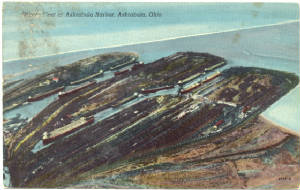
|
| Winter Fleet, Ashtabula Harbor |
| Superior Dock, Eastside of River, Westside of Dock |
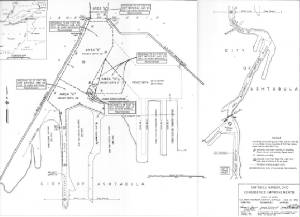
|
| Map Courtesy U.S. Army Engineers & Cleveland State |
The larryman had a fairly demanding job. He not only had to be accurate
as he weighed, but he also had to do this at a pretty good pace. It was a cardinal sin to have the hulett operator stop
and wait for you. Grandpa must have been good at it because he worked at that job for many years.
I worked on the Union Dock, which was just across the creek from the A&B
where grandpa worked. I started out a "gripper".They were the ones who would pull the r.r. cars under the huletts to be loaded.
There were two sets of cables that ran the length of the dock. These were as big around as an average cucumber. They
were situated between 1&2 tracks and 3&4 tracks and were constantly moving. Each set had a forward cable and a back
cable.
The gripper had a vice-like apparatus with a smaller twenty-foot cable with
a hook on the end. The grip would allow the large cable to slide through it. The gripper would place the hook on the r.r.
Car and when he pulled up on the 3 ft. handle of the grip it would clamp down on the moving cable and the railroad cars would
start to move, hopefully. On a cool day you could pull a string of sixteen cars at once. When the temperature reached 80 and
above there were times you could only pull three or four at a time. I did that for three seasons and then I moved up to the
larrycar.
When the Union Dock closed, the A&B Docked hired some of us. I was experienced
on the larrycar and was hired. That is how forty years later I came to run the same larrycar as grandpa .
The huletts are just a memory now. The docks are still there but they are
levelled. They still ship ore from them. The ore comes in on thousand foot long self -unloaders. There is part of one of the
huletts mounted outside of the Marine Museum in Ashtabula. It is the bucket and part of the "leg". The operator sat above
the bucket inside the leg. He controlled the bucket with one set of levers and the up and down with another set. He could
also rotate at the same time. With practice you became part of it and it was an experience to watch the old hands work.
It truly was poetry in motion.
I was just starting to learn how to run it when the dock closed. I did get
to solo a few times and it was a great experience.
Speaking of the museum, they have the hulett that "Spike" Pearson made. It
is made of metal and is an exact replica down to the tools that hung on the side, the wood planking on the catwalks and the
dock under it. It was on loan to the Smithsonian at one time, I believe. I don't know where the nickname, Spike, came from,
as he was a very mild -mannered soft-spoken man. He was my larrycar operator at the Union Dock when I was a gripper. I didn't
realize until years later how talented he was.
Your Cousin,
Dave
VISIT the HULETT MODEL
Great Lakes Marine & U.S. Coast Guard Memorial Museum
1071 Walnut Blvd.
Ashtabula, Ohio 44004
440/964-6847
Click Photos to See Closely
| Grandpa's Hulett |
|
|
| My dad took this picture of Grandpa's Dock in the Summer of 1952. |
|
"The development of the ore and coal shipping industry
on the Great Lakes ranks among the great industrial achievements of all time."
Cleveland State University Library
Add your content here
|
Pa had a stroke in 1949, forcing him to retire after 46 years on the docks. For the last 2 years of his life, Ma took care
of all his needs.
He never regained his speech or fierce independence.
It was a very hard time, but she said love and faith were with them. Pa passed away on March 8, 1951, one month after
his 68th birthday.
Ma carried on for 12 years without him. They will be remembered, honored and loved always.
|

